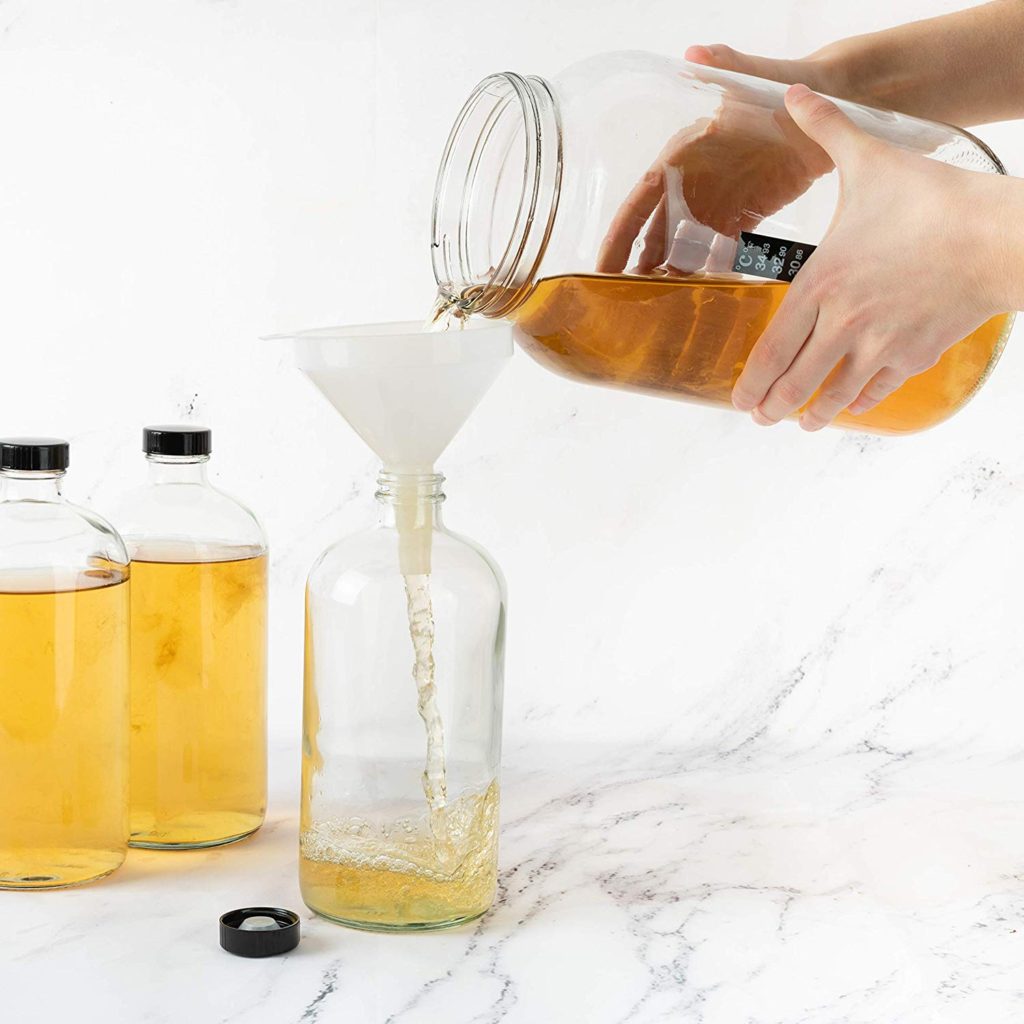Brewing kombucha is not so complex. It’s rather simple. We have a post on the step-by-step brewing process if you haven’t checked it out.
The biggest issue with brewing kombucha is with the carbonation.
Although we all have different preferences on how Kombucha should taste like, one thing Kombucha brewers tend to agree is that Kombucha should be extremely fizzy.
Depending on how you brew kombucha, kombucha can be more vinegary or sweater. And that’s totally fine!
I even once made a batch that tasted like a sweet tea mixed with a lot of water (and yes, it was terrible. A bad batch). While we mostly enjoy the variation that we unintentionally create, one thing that we always expect as a “successful” batch is a “fizzy” kombucha that is hyper-carbonated.
I struggled for many months at first to make my kombucha fizzy.

This post contains affiliate links. We earn a commission at no additional cost to you if you click our links and make a purchase. Please read our disclosure for more information.
It was alright, but not that I could call that an “extremely fizzy” taste. I tried all the different things that were suggested to make my tea more carbonated. Sometimes, it was somewhat successful, and sometimes it was just flat. Even two bottles from a same batch came out differently. I just couldn’t figure out what variable was affecting.
Now that I can easily make my kombucha extremely fizzy, I wish I knew all the setup better.
All the knowledge and information floating around the internet are typically ALL TRUE. If you still fail to make your Kombucha extremely fizzy, it is just because your issue is not the same case that you found from the internet. In other words, all the information I gathered from the internet has been just a piecemeal. And it took me a while to draw the big picture.
If your Kombucha turns out flat, there are multiple things you need to diagnose first before trying new things.
1. It is typical if it's your first batch after getting a new SCOBY. So be patient.
Your first brewing process would take longer if it’s your first or second batch ever. So be patient and keep brewing.
2. Check your bottles: No mason jars
Is your bottle a glass bottle? A plastic bottle would rather explode than keeping the carbonation in the liquid, so never store in a plastic bottle.
Is your bottleneck narrow? I love my Mason jars and have been thinking that my mason jars with stainless steal lids should be okay for my Kombucha. But this was wrong.
You might be a Mason jar lover just like me, but it’s time to set them aside and find a bottle that has a narrower bottleneck if you want the fizziness. It will help your bubbles (CO2) to melt in the liquid better and for most, you have less chance to lose the carbonation through the lid.
You might think, “my mason jar is air-tight and very sealed.” I was persistent for months to make my Kombucha fizzy from my mason jars. I bought the stainless steal lids with rubber seals specifically for my kombucha because the acidity of kombucha makes the regular mason jar’ lids bad. Mason jar can be sealed with the rubber & stainless still lids pretty well, but unfortunately, it does not keep the CO2 in the bottle.
I still use these mason jars to store my kombucha, but I don’t recommend you to use this type. Well I just don’t have enough bottles to store 2 gallons of Kombucha. So I always end up using some of mason jars for extras. And these are always less bubbly – never enough fizzy.
Bottle Type 1. Swing Top Glass Bottles with Lids
Bottle Type 2. Glass Bottles with Sealing Caps
Bottle Type 3. Glass Bottles with Stainless Steel Caps
3. You need enough yeast: Always shake your kombucha from the first fermentation to have enough yeast for the second fermentation.
When your first fermentation is done, check the bottom of the one-gallon jar. You will see some yellowish dusk on the bottom. That’s the active yeast. The black stuff floating around is dead yeast. If you are home-baker, you should be familiar with how the yeast work, and what color it is.
You will need that dusty cloud in your 2nd fermentation. When the yeast meets sugar (or fruits), it creates CO2 and makes your kombucha carbonated. I always shake the jar and make sure that the yeast is evenly distributed throughout the bottling process. If you don’t shake the jar, you will find the yeast sitting on the bottom of the jar.
4. You need enough sugar: Did you add enough sugar for the second fermentation?
Depending on your environment and the way you brew, you will have a different measurement.
In the case I don’t add any fruits, in my 16 oz bottle, I like to add 1/2 tsp of sugar.
Don’t be scared of adding the “unhealthy sugar’ in your wholesome drink. It’s okay. During the 2nd fermentation process, the yeast will consume all the sweetness.
If you can still taste the sweetness and you don’t like it, just keep it in the room temperate 12~24 hours so the yeast can eat the sugar more.
Based on my experience, one strawberry makes more carbonation than a 1/4 tsp sugar. I felt like the fizziness almost doubled.
But don’t add too much sugar before experimenting enough. You probably don’t want to make a mess in the kitchen from a kombucha explosion. You will also need to burp the bottle every day to avoid the mess.
In my brewing environment, 1/2 tsp of sugar works perfectly for 16 oz in order to make the kombucha fizzy enough to drink without having to burp the bottle.
This rule of thumb can vary depending on your environment: temperature, bottle type, 1st fermentation duration, etc. So don’t rely on my measurement. Finding your own rule of thumbs would make your life easier. Of course when it comes to fresh/frozen fruits, there is always an expectancy. The first time I added real fruits (frozen pineapple or fresh strawberry), I had to dump half of the liquid because it exploded when I opened the bottle. And the remaining kombucha was just flat. It’s like you shake your coke and let it explode, and what’s left is no coke anymore.
If you are experiencing this, it’s time to either reduce the amount of sugar, or burp the bottle every day so it does not explode when you open it.
5. Is my scoby an unlucky low quality? Probably not.
Some people say that some SCOBY tends to produce less fizziness, so you should try a different SCOBY. Well, I almost thought there was something wrong with my scoby after many failures for months. But I’m glad I didn’t give up or spend money to get a new scoby. Unless you have a significant issue with your SCOBY like color change and bad smell, you are just fine. If you are just trying to make your kombucha fizzier, I recommend not blaming your scoby. Probably, the cause is not from your scoby.
Wrapping up…
Hope this post helps you if you are like me who wants the fizzy kombucha!
Every time when I have an issue of a flat kombucha, these are the points I double check. And typical issue always falls under these three points.
- Are my bottles still capturing the carbonation well enough? Have I used them too long?
- Did I add enough sugar and wait enough to build up the carbonation?
- Did I shake well and make sure to add enough yeast for the second fermentation?
- Additionally, give some time for the carbonation to build up.
My husband and I have been enjoying kombucha so much, and brewing kombucha has become a part of our life. I am excited to share what I have learned from brewing kombucha and plan on sharing more.
If you want to know how we make our kombucha step by step, click this link to find the post.
Happy brewing!
Related posts in this category:
Like this post? Share with the world!

Sharing is caring!



Thanks so much for sharing. I made my first batch and it was flat. I added strawberries, it was very good but flat. I am a bit frustrated but you have helped me to keep trying. ??